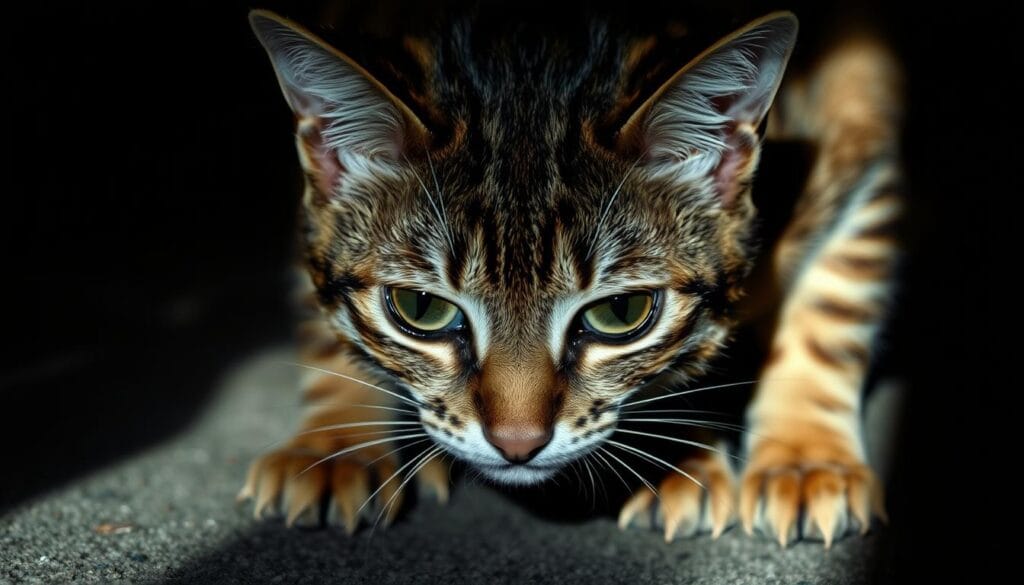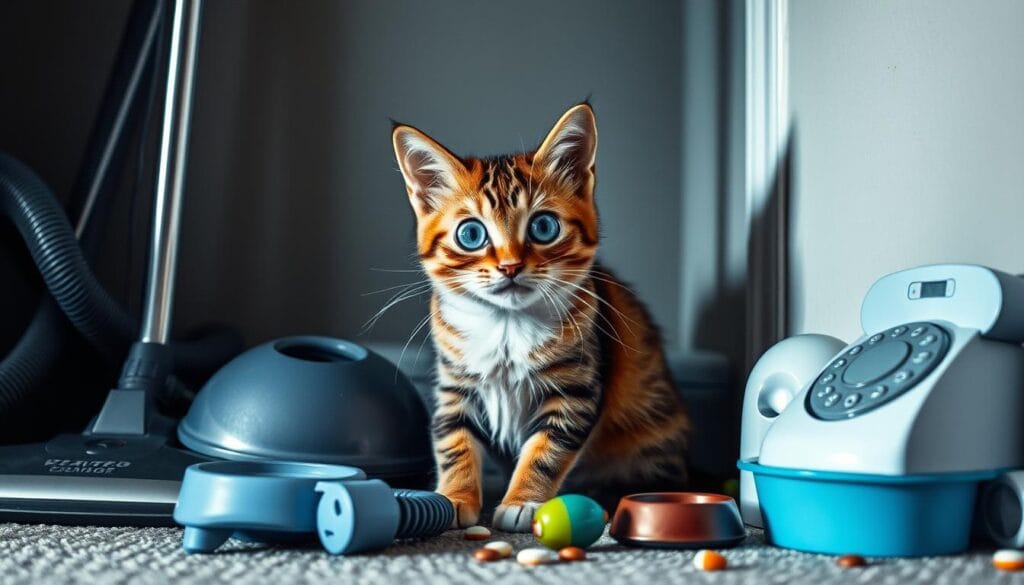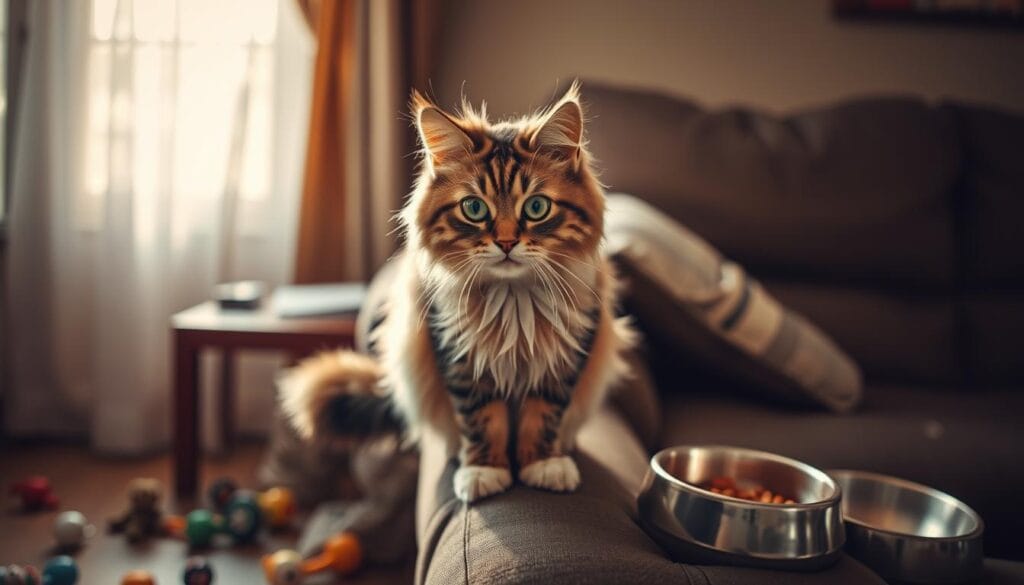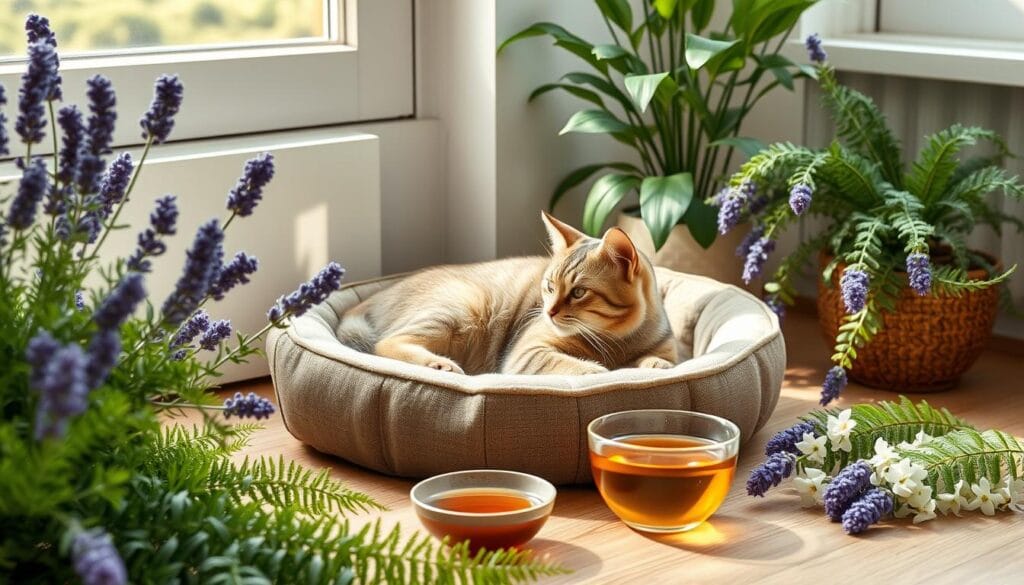As a devoted pet owner, you know your cat’s well-being is key. But have you thought about if your cat might be anxious? Cat anxiety is real and often missed, affecting your pet’s health and mood. How can you spot the signs and help your cat feel better?

Key Takeaways
- Cat anxiety is a common condition that can affect your pet’s overall health and behavior.
- Recognizing the five key signs of feline anxiety can help you address the issue proactively.
- Understanding the physical and behavioral manifestations of anxiety is crucial for providing the right care and support for your cat.
- Addressing the root causes of your cat’s anxiety can help alleviate their stress and improve their well-being.
- Seeking professional guidance can ensure your cat receives the appropriate treatment and management strategies for their specific needs.
What Exactly Is Cat Anxiety and Why Does It Matter?
Cat anxiety affects a cat’s happiness and health. It shows as fear, stress, and worry. These feelings can change how a cat acts and feels physically. Knowing about cat anxiety helps pet owners keep their cats happy and healthy.
Physical vs. Behavioral Manifestations of Anxiety
Cat anxiety can cause physical signs like changes in eating, stomach problems, and too much grooming. It can also show in how a cat acts, like meowing more, hiding, and not wanting to play. Watching for these signs helps understand how your cat feels.
The Impact of Anxiety on Your Cat’s Well-being
Long-term feline stress indicators harm a cat’s health. It can make them sick more often. It also makes them unhappy, making it hard for them to play and enjoy their space.
| Physical Symptoms | Behavioral Changes |
|---|---|
| Changes in appetite Digestive problems Excessive grooming Increased susceptibility to illness | Increased vocalization Hiding or avoidance of social interaction Restlessness or pacing Decreased activity levels |
Understanding cat anxiety symptoms helps pet owners help their cats. It ensures they have a good life.
Cat Anxiety: Common Triggers and Root Causes
Understanding the causes of cat anxiety and the feline stress triggers is key. Many factors can make cats anxious, from changes in their environment to social issues.
Disruptions in a cat’s familiar environment can cause a lot of stress. Moving to a new home or changing furniture can upset them. Cats like routine and predictability, and any changes can make them anxious.
Introducing new pets or family members can also stress cats out. They see these changes as threats to their safety and territory. This can lead to more anxiety in cats.
Loud noises, like construction or fireworks, can also upset cats. Their sensitive hearing makes these sounds overwhelming. This can make them feel unsafe in their own home.
Genetics and early life experiences can also affect a cat’s anxiety. Cats that have faced trauma or neglect may be more anxious later on.
Knowing the common triggers and root causes of cat anxiety is the first step. By understanding what causes their stress, you can help them naturally. You can create a calm and supportive environment for your pet.

Recognizing Physical Signs of Feline Stress
Understanding your cat’s physical signs can give you insight into their emotional state. As a pet owner, knowing the cat anxiety symptoms, physical signs of cat stress, and feline body language helps you spot when they’re anxious or stressed.
Changes in Eating and Grooming Habits
Changes in eating and grooming habits can signal stress. Watch for changes in appetite, like not wanting to eat or eating too much. Also, notice if your cat is grooming too much or not enough. This can show they’re feeling anxious.
Physical Symptoms to Watch For
- Digestive issues, such as vomiting or diarrhea
- Increased heart rate and rapid breathing
- Trembling or shaking
- Hair loss or excessive shedding
- Increased sleeping or lethargy
Body Language Indicators
Watching your cat’s body language can tell you a lot about their feelings. Look for signs like big pupils, a tense body, and a tucked-in tail. They might also seem always on guard, looking for threats.
By noticing these physical signs of cat stress, you can act to help your cat feel better. You can make their environment calmer and more comfortable.
Behavioral Changes That Signal Anxiety in Cats
Understanding anxious cat behavior can be done by watching your cat’s changes. Cats are very sensitive and show clear signs of feline stress responses and cat anxiety signs.
One sign of anxiety in cats is more aggression. Cats that are usually calm might start to hiss or bite when stressed. This change in behavior is a warning that your cat is not okay.
Another sign is when cats start to hide more. Cats that used to enjoy playing with you might now stay alone. They hide to feel safe and comfortable.
- Meowing or yowling more than usual can also mean your cat is anxious. They might be trying to tell you they’re upset.
- Scratching or damaging things is another sign of anxiety. Cats might do this to try to control their environment.
These changes are not just bad habits. They show that your cat is struggling inside. Knowing about feline stress responses and cat anxiety signs helps you help your cat.

| Behavioral Change | Potential Causes | Implications |
|---|---|---|
| Increased Aggression | Feeling threatened or overwhelmed | Dangerous for both the cat and their caretakers |
| Withdrawal and Hiding | Seeking a sense of safety and comfort | Disruption of social bonding and potential health issues |
| Excessive Vocalization | Expressing distress or discomfort | Indication of an underlying problem that needs addressing |
| Destructive Behavior | Coping mechanism for anxiety | Potential damage to property and escalation of the problem |
Environmental Factors Contributing to Your Cat’s Stress
As pet owners, we must know that cats can be sensitive to many things around them. These can cause cat anxiety and stress. Watching your cat’s surroundings and fixing any stressful environments for cats can help a lot.
Home Environment Changes
Even small changes at home can upset your cat’s sense of safety and comfort. Rearranging furniture, adding new items, or doing renovations can be feline stress factors. These changes can make your cat anxious and lead to bad behaviors.
Social Dynamics and Pet Interactions
The way your cat gets along with other pets or family members can also cause cat anxiety triggers. Changes like getting a new pet or less attention from family can upset your cat. This can make them stressed.
External Stressors
Things outside the home, like loud construction, bad weather, or strangers, can also stress your cat. Knowing about these stressful environments for cats lets you help your cat feel better.
Understanding what causes cat anxiety triggers and stress can help you make your cat’s life better. You can make their home calmer and more loving. This will make your cat happier and more content.
Natural Remedies for Calming an Anxious Cat
As a cat owner, you want the best for your furry friend, especially when they’re anxious. Luckily, there are many natural ways to calm an anxious cat. From pheromone diffusers to calming music, these methods are gentle and effective.
Pheromone diffusers or sprays are a popular choice for cat anxiety. They mimic the natural pheromones cats use to feel safe. Regular use can make your cat’s environment more calming and reduce anxiety.
Calming music is another great way to soothe an anxious cat. Research shows that certain music, like classical or soft instrumental, can calm cats. Playing this music in your cat’s favorite spots can make them feel more at ease.
Herbal supplements are also a natural option for cat anxiety. Chamomile, valerian root, and l-theanine can calm cats. Always check with your vet before giving your cat supplements to make sure they’re safe.
Environmental enrichment is key in reducing cat anxiety. Give your cat lots of hiding spots, scratching posts, and toys. Playing with your cat regularly and offering different activities can also help reduce boredom and stress.
Remember, every cat is different, so what works for one might not work for another. Try different natural remedies and see what works best for your cat. With these gentle techniques, you can help your anxious cat feel more calm and happy.

When to Consider Anxiety Medications for Your Cat
As a loving pet parent, you want the best for your cat. Sometimes, cat anxiety needs more than natural remedies. In these cases, anxiety medications might be the best choice for your cat’s health and happiness. Let’s look at when treatment for cat stress from a vet is needed.
Types of Available Medications
Your vet might suggest different feline anti-anxiety medication options. These include SSRIs, tricyclic antidepressants, and benzodiazepines. These meds help balance brain chemicals that cause anxiety in cats.
- SSRIs, like fluoxetine (Prozac), help manage anxiety over time.
- Tricyclic antidepressants, such as amitriptyline, can also help with anxiety.
- Benzodiazepines, like alprazolam (Xanax), offer quick relief but are for short-term use.
Consultation with Your Veterinarian
Before starting any cat anxiety tablets or meds, talk to your vet. They’ll check your cat’s health, look for any other health problems, and choose the best treatment. It’s important to get a proper diagnosis and watch your cat closely while using feline anti-anxiety medication.
“Medication should always be a last resort, and your veterinarian will work with you to explore all possible options before prescribing any cat anxiety tablets,” says Dr. Jane Doe, a leading veterinary behaviorist.
Your cat’s happiness is the most important thing. With the right help, your cat can beat anxiety and live a joyful life.
Creating a Stress-Free Environment for Your Pet
Creating a cat-friendly home is key to reducing stress in cats. It helps make anxiety-free cat spaces. By knowing what your cat needs, you can make a home that’s calm and happy.
Safe spaces are vital for a stress-free environment. Think about cozy hideaways, high spots, or quiet areas. These spots help your cat feel safe. Also, make sure the litter box is in a quiet, easy-to-get-to spot.
- Give your cat anxiety-reducing toys and fun activities to keep them busy.
- Stick to a routine, as cats like things the same and don’t like surprises.
- Try calming pheromone diffusers or sprays to make your home feel peaceful.
Focus on your cat’s happiness and safety. This way, you can make a cat-friendly home. It will help reduce stress and make your cat feel secure.
| Design Element | Purpose |
|---|---|
| Safe Spaces | Provide areas for your cat to retreat and feel secure |
| Litter Box Placement | Ensure quiet, accessible location for your cat’s needs |
| Anxiety-Reducing Toys | Engage your cat’s natural behaviors and reduce boredom |
| Predictable Routine | Maintain a sense of stability and familiarity for your cat |
| Calming Pheromones | Create a soothing atmosphere throughout your home |
“A calm and comfortable environment is essential for the well-being of your feline companion.”
Prevention Strategies and Long-term Management
To prevent cat anxiety and manage stress, you need a few steps. Adjusting daily routines and enriching the environment are key. These steps help tackle the main causes of feline anxiety prevention.
Daily Routine Adjustments
Keeping a regular daily schedule is vital for cats. It makes them feel safe and lowers anxiety. Make sure their meals, playtime, and sleep are on a set schedule. Slow changes help them adjust better.
Environmental Enrichment Tips
Creating a fun and engaging space is crucial for preventing cat anxiety. Add toys, scratching posts, and places to rest high up. Change toys often to keep things interesting. Also, set up cozy spots for your cat to hide and relax.
| Environmental Enrichment Strategies | Benefits for Reducing Feline Anxiety |
|---|---|
| Providing interactive toys and puzzles | Promotes mental stimulation and natural hunting behaviors |
| Introducing vertical scratching posts | Allows cats to display their instinctive scratching behavior |
| Creating cozy, hiding spots | Offers a sense of security and a safe retreat when needed |
| Rotating new toys and enrichment items | Maintains your cat’s interest and prevents boredom |
By using these long-term stress management for cats methods, you can stop anxiety before it starts. This creates a peaceful and happy home for your cat.
Seeking Professional Help for Cat Anxiety
Managing your cat’s anxiety can sometimes need professional help. Cat behaviorists, veterinarians specializing in veterinary anxiety treatment, and feline mental health specialists are key in diagnosing and treating anxiety in cats.
If your cat’s anxiety is severe, it’s wise to talk to a cat behaviorist or a vet who knows about veterinary anxiety treatment. They can do a detailed check, find out why your cat is anxious, and make a plan to help them feel better.
Your vet might also suggest seeing a feline mental health specialist. They can offer special treatments like behavior therapy or anti-anxiety meds if needed. These experts know a lot about helping cats with complex emotional and behavioral issues.
Getting help from the right cat behaviorist, vet, or feline mental health specialist can really help your cat. With the right help, your cat can feel safe again and live a happier life.
“Seeking professional help for your cat’s anxiety can be the key to unlocking their full potential and helping them thrive in their home environment.”
Conclusion
In this guide, we’ve looked into managing cat anxiety. We’ve covered the physical and behavioral signs of stress in cats. We also talked about common causes and how to address them.
Understanding cat mental health care is crucial. It helps you support your cat’s well-being. By doing so, you can help them live a happy life.
It’s important to notice the signs of feline stress relief early. Look for changes in eating, grooming, body language, and activity. These signs can help you act fast to reduce anxiety.
With natural remedies, changes in the environment, and vet advice, you can make your cat’s space calm and loving. This helps them feel safe and relaxed.
Your cat’s health and happiness should always come first. By focusing on their mental health care and getting help when needed, you can strengthen your bond. This ensures they have a happy and stress-free life.
Remember, your cat’s well-being is in your hands. Take the steps to manage their anxiety. Give them the love and support they need.
FAQ
What are the most common signs of anxiety in cats?
Signs of anxiety in cats include excessive grooming and loss of appetite. They might hide or withdraw and become more vocal. They may also exhibit destructive behaviors like scratching or urinating outside the litter box.
What can trigger anxiety in cats?
Cats can get anxious due to many things. Changes in their environment, like moving or getting new pets, can upset them. Loud noises and being separated from owners also cause stress. Some medical conditions can trigger anxiety too.
How can I help an anxious cat naturally?
To calm an anxious cat, you can use pheromone diffusers and play calming music. Providing environmental enrichment and introducing herbs or supplements for anxiety can also help.
When should I consider medication for my cat’s anxiety?
If your cat’s anxiety is severe and natural remedies don’t help, talk to your vet. They can discuss prescription medications or other treatments.
How can I create a stress-free environment for my anxious cat?
To make a stress-free space for your cat, give them safe areas and the right litter box. Use calming scents and keep a daily routine. This helps them feel secure and comfortable.
IMPORTANT ADDITIONS
Edited on , 08 NOV ,2024
Read more articles : https://petsfeeling.com/blog-2/
social media :
facebook : https://www.facebook.com/PetsFeeling0/
tiktok : https://www.tiktok.com/@pets.feeling
instagram : https://www.instagram.com/pets._.feeling/
youtube : https://www.youtube.com/@Pets-Feeling

